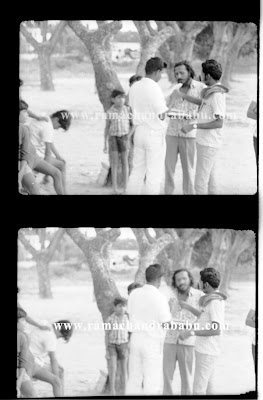Which is India's First 70mm Film ?
Usually the answer given to the above question is SHOLAY, released in 1975.
Because it was a highly successful Box Office hit, every one thought it must be so. But the fact is Pachhi’s 'AROUND THE WORLD' (1967/ Technicolor) was the first Indian
film to be actually released in the 70mm widescreen format, and also the
first with a magnetic, six-track stereophonic soundtrack. Just watch the opening credit sequence and the answer is crystal clear!
 |
| From the Opening Titles |
Since actual 70mm (or 65mm) cameras and film were very expensive
at the time, both 'Around the World' and ‘Sholay’ were shot on
traditional 35mm film and the Academy 1.37:1 ratio picture was subsequently blown up,
cropped and matted to a 1: 2.21 ratio 70mm frame. Later films like "Padayottam,"‘The Burning Train,’ ‘Shaan’ and subsequent ‘70mm films’
were shot in CinemaScope, which has almost the same ‘aspect ratio of 1:2.35 and hence
there was negligible loss of image on the sides.
 |
| The original Academy aperture and the 70 mm Blow up area |
 |
| A Frame from Padayottam |
In the case of both 'Around the World' and 'Sholay' exactly four 70mm
prints were released in the first instance: two were allotted to the
Bombay-Maharashtra territory, and one each to Delhi and U.P. And yet
both films were screened in 70mm at two cinema halls in Delhi ('Around The World' at
Odeon and Liberty and 'Sholay' at Plaza and Liberty). This was achieved
by shuttling the 70mm print allotted to Delhi between the two halls. T
he Malayalam 70 mm film PADAYOTTAM also had only Four 70mm prints taken and was released in Trivandrum, Ernakulam, Trichur and Calicut centres.
Over the decades 'Sholay' has acquired such a dedicated fan following
that fans insist that it was India's first film in 70mm and six-track
stereophonic sound, even though the film's makers have never made any
such claim.Now that we are celebrating the Centenary of Indian Cinema we should correct such errors which may pass down in to the History of Cinema.
Question No: 2
Which is India's First CinemaScope Film ?
The most common answer will be ‘Kaagaz Ke Phool’ (Hindi-Urdu, 1959) (Hindi -1959) B & W, CinemaScope film which was done in technical collaboration
with 20th Century Fox.
In a way the answer is correct. But CinemaScope is the Registered Trade Mark of 20 th Century Fox
International Corporation and Royalty had to be paid for the use of the
name "CinemaScope" in the publicity material.
 |
| Licence from 20 th Century Fox |
In order to overcome that various countries developed their own widescreen systems such as Hypergoner, Superscope, Technirama, Superscope 235, Techniscope, Arriscope, SovScope, etc. all employing 2X Anamorphic processes.
The bilingual Indo-Soviet film ‘Pardesi’ (Hindi-Urdu/ Russian/ dirs:
Khwaja Ahmad Abbas, Vasili M. Pronim) was released in 1957. The film is
called ‘Khozhdenie za tri morya’ in Russian and
its subtitled English version is known as ‘Journey Beyond Three Seas.’
India’s first wide-screen film was in SovColor. However, even though it
starred Nargis, the most successful heroine of the time, this biopic
about Afanasi, a 15th century Russian explorer in India, did not get a
release beyond a few left-leaning art house cinemas. It was shot using the SovScope Anamorphic processes which was quite similar to CinemaScope. Its Censor Certificate states ‘Colour, Scope’ and gives the name of its
filmmakers as ‘Meera Movies’ and ‘Son[?]a Sansar International'. Some songs in colour as well as in Black and White is available for viewing in YouTube. Can this film be considered as India’s first wide-screen ( Scope) film ?
While viewing Pardesi I was struck by the uncanny resemblance to the lighting style employed in a dance sequence, to that of Kaagaz Ke Phool which came two years later!
 | |
| Pardesi 1957 |
.jpg) |
| Kaagaz Ke Phool 1959 |
Both the Cinematographers thought alike!
It is time for our historians to rethink and rewrite the History of Indian Cinema in this Centenary Year with more and more research.
For More details Click HERE for Indiapedia article - CinemaScope films in Bangladesh, India, Nepal, Pakistan, Sri Lanka


















